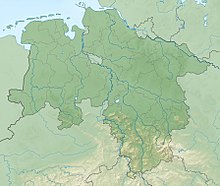Haselünner juniper grove
Coordinates: 52 ° 39 ′ 32.4 " N , 7 ° 29 ′ 52.8" E
The Haselünner Juniper Grove is an area of 36 hectares on the edge of the town of Haselünne in Emsland . It is part of the 72 hectare former nature reserve "Haselünner Kuhweide", declared in 1999 , which has been part of the newly designated nature reserve " Natura 2000 nature reserve in the lower Haseniederung " since July 1, 2017 .
Juniper Grove

The area has been used as pasture since the Middle Ages. This specifically prevents the formation of forest, as otherwise the juniper would be displaced.
The recently introduced grazing by Scottish highland cattle is hoped for a lasting "care effect". If the population is properly balanced, the cattle are able to stop advanced bush encroachment. The non-selective feeding behavior of these animals is advantageous in that plants such as thistles , sloes , alders , rushes , reeds and elderberries also serve as food.
The Haselünner Juniper Grove - like others - has to struggle with the threatening phenomenon that there have been no young plants for years. It is hoped that grazing can significantly improve the living conditions for seedlings.
There is also a herd of " Tarpan " horses (breeding images) on the site .
Immediately after the last foothills of Haselünne, the mixed forest surrounding the nature park begins with oaks , alders , birches and pines . The park is naturally bounded by the arched river bed of the Hase . Juniper not only grows sporadically here, but also in light groves and dense, barely penetrable hedges .
This natural combination of meadows, the old arms of the Hase, swampy lowlands and sandy-dry heathland represents a unique, park-like landscape. The area is accessible to visitors through a nature trail.
Common names of the juniper are Wachelduren , Jachelbeerstrauch , Reckholder , Machandel , Kranewitt and Kaddig . Haselünne's spirits producers have always appreciated and used the “raw material juniper” in their area.
Flora Haseauen

Mixed forest with a large proportion of pines (Pinaceae)
The juniper grove is criss-crossed by a few troughs, which house numerous aquatic plants. So you can find among other things:
- The arrowhead ( Sagittaria sagittifolia )
- Hedgehog family ( Sparganiaceae )
- Water fennel ( Oenanthe aquatica )
- Water feather ( Hottonia palustris )
Haseau revitalization

In order to develop and maintain the Hase and its floodplain in the long term, the Association for the Revitalization of Haseauen eV was founded in 1997 by the districts along the Hase and the independent city of Osnabrück .
In the Lower Hasetal , in a section of the river between Haselünne and Meppen, a typical floodplain landscape is to develop again after completion of the hydraulic engineering measures, which were carried out as part of an E + E project that has been running since 1998 . By relocating the dykes , a retention area was created in which the annual, seasonal floods of the Hase can spread. As a result, the areas of the river plains lying further down are spared from flooding. The floodplains created in this way, close to the river, now offer the possibility of developing a floodplain landscape with the flora and fauna characteristic of this type of landscape.
fauna
Other mammal species have begun to be reintroduced - the swamp mouse ( Microtus oeconomus ) and the European mink ( Mustela lutreola ). At the beginning of the 1990s, the hare and the Eurasian beaver ( Castor fiber albicus ) were successfully reintroduced on this section of the river .
literature
- V. Blümel, A. Degen: Influences on the activity budget of overwintering whooper swans (Cygnus cygnus) in the middle Hasetal (Lower Saxony) . - Vogelkdl. Ber. Lower Saxony. 34: 29-42. 2002.
- Tobias Böckermann : Hude landscapes in the Emsland - living contemporary witnesses. About the origin of “Borkener Paradies”, “Haselünner Wacholderhain” and the old heathen . In: Emsländische Geschichte Volume 14/2007, Haselünne 2007, pp. 416–435.
- H. Düttmann, T. Assmann, K.-D. Moormann: The animal world of the Emsland. In: W. Franke, H. Schüpp, G. Steinwascher (eds.): The district of Emsland. Geography, history, present. A circle description. Meppen, 202-219. 2002.
- B. Klenner-Fringes, R. Schröpfer: The behavior of beavers Castor fiber albicus MATSCHIE 1907 after translocation to a resettlement area. - Contribution to the 6th Symposium Ethology and Nature Conservation of the Ethological Society eV in Osnabrück, 2001.
- Carl Altehage : Wacholderhain Haselünne nature reserve. In: Mitt. Dt. Dendrol. Law No. 59. 1955/56. Darmstadt. P. 135.
- Reinhold Tüxen : The Haselünner cow pasture. The plant communities of a medieval communal pasture. In: Mitt. Flor.-soz. Arbeitsgem. NF, issue 17. 1974. Todenmann. Pp. 69-102, 15 tab.
- Gudrun Madsen: The "Haselünner Kuhweide" nature reserve - development, current vegetation and care measures. Diploma thesis, University of Münster (unpublished), 1987.
- Ernst Burrichter : Tinner Loh, Borkener Paradies and Haselünner Wacholderhain . Yearbook Emsland. Heimatbund, Vol. 34. 1988. Sögel. Pp. 168-207.




